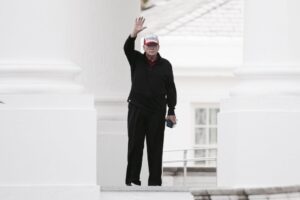Every Easter, public figures across the political spectrum take to social media or issue official statements to commemorate the holiday. Typically, these messages focus on themes of hope, renewal, and faith. But this year, former President Donald Trump’s Easter message stirred a very different kind of conversation—one fraught with controversy, backlash, and media scrutiny.
In this post, we’ll break down what Trump said, why critics were outraged, how supporters responded, and what this episode reveals about the current political and cultural climate in America.
What Did Donald Trump Say in His Easter Message?
On Easter Sunday 2025, Donald Trump issued a statement that diverged sharply from the traditional tone of the holiday. Instead of focusing solely on religious or uplifting themes, Trump used the opportunity to lash out at political opponents, ongoing legal cases, and what he described as the “corrupt justice system.”
In part, Trump’s message read:
“Happy Easter to all, including those who are trying to destroy our country, rig our elections, and weaponize the law against their political enemies…”
The statement continued with pointed remarks that many interpreted as attacks on prosecutors, judges, and members of the Democratic Party.
While Trump has a long history of using holidays and national events to make political statements, the choice to embed such rhetoric in an Easter message—a day considered sacred by millions of Christians—sparked immediate and widespread reactions.
Why Did This Message Spark Outrage?

Critics from across the political and religious spectrum expressed concern, disappointment, and outrage over the tone and content of Trump’s message.
1. Religious Insensitivity:
Many religious leaders and faith-based communities argued that Trump’s message was inappropriate for a day meant to honor the resurrection of Jesus Christ and the core Christian values of love, forgiveness, and grace.
2. Politicization of a Sacred Holiday:
Critics said Trump used Easter—a unifying and spiritual occasion—for divisive political rhetoric, turning what should be a moment of reflection into a partisan battleground.
3. Escalating Rhetoric Amid Legal Troubles:
With Trump facing multiple legal investigations and ongoing court cases, some viewed the message as an attempt to further delegitimize the judicial process and paint himself as a victim of political persecution.
Supporters See a Different Message

Despite the backlash, Trump’s base remained largely supportive. Many of his followers praised the message as bold and truthful, viewing it as a necessary stand against what they believe is a biased and unjust political system.
1. “Telling It Like It Is”:
Supporters say Trump’s candor is what sets him apart, arguing that he speaks truths others are afraid to say—even on holidays.
2. A Call to Action:
For Trump loyalists, the message wasn’t offensive—it was a rallying cry. Some believe Easter, symbolizing resurrection and new beginnings, was the perfect time to reenergize political momentum.
3. Media Double Standards:
Many also accused the media of selectively amplifying outrage while ignoring what they perceive as inflammatory statements from politicians on the left.
The Bigger Picture: Politics, Faith, and Public Discourse
This controversy underscores a deeper tension in American society: the intersection of faith, politics, and public expression. As political polarization intensifies, even traditionally apolitical or spiritual moments—like Easter—are becoming arenas for ideological conflict.
1. The Erosion of Common Ground:
What once served as a moment of shared values is now seen through a partisan lens. Trump’s message is a stark reminder of how fractured American political discourse has become.
2. The Role of Leaders During Holidays:
Public figures have a unique platform during holidays to unite, inspire, and uplift. When those moments are used to divide or attack, the public reaction tends to be sharp and swift.
3. The Power of Messaging:
Trump’s Easter message, whether viewed as inappropriate or courageous, demonstrates how a few words from a political figure can dominate the news cycle, mobilize support, and provoke outrage—all at once.
Final Thoughts: Why It Matters
Donald Trump’s Easter message has once again ignited debate not just about him, but about the broader direction of American culture and political engagement. For some, it was a breach of decorum and a desecration of a sacred day. For others, it was another example of Trump speaking his mind and defying norms.
As the country heads deeper into a heated election season, incidents like this one remind us that the divide in American society isn’t just political—it’s cultural, spiritual, and deeply personal.
In the end, whether one sees Trump’s Easter message as bold or blasphemous, it reflects the turbulent era we live in—where even a holiday greeting can become a flashpoint for national debate.
